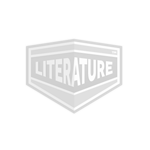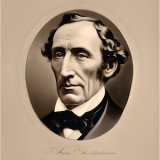The Metal Pig
"The Metal Pig" is a captivating tale by Hans Christian Andersen about a young boy named Gabriele, who is poor and homeless. Gabriele's life changes when he encounters a metal pig statue in front of a rich house and artistically engages with the statue. This experience makes him develop a significant passion and talent for art. He finally gets the attention of a noble family that allows him to live with them and nurture his artistry. The book highlights how one's life can take unpredictable turns and the impact of art on individuals.
In the city of Florence, not far from the Piazza del Granduca, runs a little street called Porta Rosa. In this street, just in front of the market-place where vegetables are sold, stands a pig, made of brass and curiously formed. The bright color has been changed by age to dark green; but clear, fresh water pours from the snout, which shines as if it had been polished, and so indeed it has, for hundreds of poor people and children seize it in their hands as they place their mouths close to the mouth of the animal, to drink. It is quite a picture to see a half-naked boy clasping the well-formed creature by the head, as he presses his rosy lips against its jaws. Every one who visits Florence can very quickly find the place; he has only to ask the first beggar he meets for the Metal Pig, and he will be told where it is. It was late on a winter evening; the mountains were covered with snow, but the moon shone brightly, and moonlight in Italy is like a dull winter's day in the north; indeed it is better, for clear air seems to raise us above the earth, while in the north a cold, gray, leaden sky appears to press us down to earth, even as the cold damp earth shall one day press on us in the grave. In the garden of the grand duke's palace, under the roof of one of the wings, where a thousand roses bloom in winter, a little ragged boy had been sitting the whole day long; a boy, who might serve as a type of Italy, lovely and smiling, and yet still suffering. He was hungry and thirsty, yet no one gave him anything; and when it became dark, and they were about to close the gardens, the porter turned him out. He stood a long time musing on the bridge which crosses the Arno, and looking at the glittering stars, reflected in the water which flowed between him and the elegant marble bridge Della Trinita. He then walked away towards the Metal Pig, half knelt down, clasped it with his arms, and then put his mouth to the shining snout and drank deep draughts of the fresh water. Close by, lay a few salad-leaves and two chestnuts, which were to serve for his supper. No one was in the street but himself; it belonged only to him, so he boldly seated himself on the pig's back, leaned forward so that his curly head could rest on the head of the animal, and, before he was aware, he fell asleep. It was midnight. The Metal Pig raised himself gently, and the boy heard him say quite distinctly, "Hold tight, little boy, for I am going to run;" and away he started for a most wonderful ride. First, they arrived at the Piazza del Granduca, and the metal horse which bears the duke's statue, neighed aloud. The painted coats-of-arms on the old council-house shone like transparent pictures, and Michael Angelo's David tossed his sling; it was as if everything had life. The metallic groups of figures, among which were Perseus and the Rape of the Sabines, looked like living persons, and cries of terror sounded from them all across the noble square. By the Palazzo degli Uffizi, in the arcade, where the nobility assemble for the carnival, the Metal Pig stopped. "Hold fast," said the animal; "hold fast, for I am going up stairs." The little boy said not a word; he was half pleased and half afraid. They entered a long gallery, where the boy had been before. The walls were resplendent with paintings; here stood statues and busts, all in a clear light as if it were day. But the grandest appeared when the door of a side room opened; the little boy could remember what beautiful things he had seen there, but to-night everything shone in its brightest colors. Here stood the figure of a beautiful woman, as beautifully sculptured as possible by one of the great masters. Her graceful limbs appeared to move; dolphins sprang at her feet, and immortality shone from her eyes. The world called her the Venus de' Medici. By her side were statues, in which the spirit of life breathed in stone; figures of men, one of whom whetted his sword, and was named the Grinder; wrestling gladiators formed another group, the sword had been sharpened for them, and they strove for the goddess of beauty. The boy was dazzled by so much glitter; for the walls were gleaming with bright colors, all appeared living reality. As they passed from hall to hall, beauty everywhere showed itself; and as the Metal Pig went step by step from one picture to the other, the little boy could see it all plainly. One glory eclipsed another; yet there was one picture that fixed itself on the little boy's memory, more especially because of the happy children it represented, for these the little boy had seen in daylight. Many pass this picture by with indifference, and yet it contains a treasure of poetic feeling; it represents Christ descending into Hades. They are not the lost whom the spectator sees, but the heathen of olden times. The Florentine, Angiolo Bronzino, painted this picture; most beautiful is the expression on the face of the two children, who appear to have full confidence that they shall reach heaven at last. They are embracing each other, and one little one stretches out his hand towards another who stands below him, and points to himself, as if he were saying, "I am going to heaven." The older people stand as if uncertain, yet hopeful, and they bow in humble adoration to the Lord Jesus. On this picture the boy's eyes rested longer than on any other: the Metal Pig stood still before it. A low sigh was heard. Did it come from the picture or from the animal? The boy raised his hands towards the smiling children, and then the Pig ran off with him through the open vestibule. "Thank you, thank you, you beautiful animal," said the little boy, caressing the Metal Pig as it ran down the steps. "Thanks to yourself also," replied the Metal Pig; "I have helped you and you have helped me, for it is only when I have an innocent child on my back that I receive the power to run. Yes; as you see, I can even venture under the rays of the lamp, in front of the picture of the Madonna, but I may not enter the church; still from without, and while you are upon my back, I may look in through the open door. Do not get down yet, for if you do, then I shall be lifeless, as you have seen me in the Porta Rosa." "I will stay with you, my dear creature," said the little boy. So then they went on at a rapid pace through the streets of Florence, till they came to the square before the church of Santa Croce. The folding-doors flew open, and light streamed from the altar through the church into the deserted square. A wonderful blaze of light streamed from one of the monuments in the left-side aisle, and a thousand moving stars seemed to form a glory round it; even the coat-of-arms on the tomb-stone shone, and a red ladder on a blue field gleamed like fire. It was the grave of Galileo. The monument is unadorned, but the red ladder is an emblem of art, signifying that the way to glory leads up a shining ladder, on which the prophets of mind rise to heaven, like Elias of old. In the right aisle of the
Translation
Translate and read this book in other languages:
Select another language:
- - Select -
- 简体中文 (Chinese - Simplified)
- 繁體中文 (Chinese - Traditional)
- Español (Spanish)
- Esperanto (Esperanto)
- 日本語 (Japanese)
- Português (Portuguese)
- Deutsch (German)
- العربية (Arabic)
- Français (French)
- Русский (Russian)
- ಕನ್ನಡ (Kannada)
- 한국어 (Korean)
- עברית (Hebrew)
- Gaeilge (Irish)
- Українська (Ukrainian)
- اردو (Urdu)
- Magyar (Hungarian)
- मानक हिन्दी (Hindi)
- Indonesia (Indonesian)
- Italiano (Italian)
- தமிழ் (Tamil)
- Türkçe (Turkish)
- తెలుగు (Telugu)
- ภาษาไทย (Thai)
- Tiếng Việt (Vietnamese)
- Čeština (Czech)
- Polski (Polish)
- Bahasa Indonesia (Indonesian)
- Românește (Romanian)
- Nederlands (Dutch)
- Ελληνικά (Greek)
- Latinum (Latin)
- Svenska (Swedish)
- Dansk (Danish)
- Suomi (Finnish)
- فارسی (Persian)
- ייִדיש (Yiddish)
- հայերեն (Armenian)
- Norsk (Norwegian)
- English (English)
Citation
Use the citation below to add this book to your bibliography:
Style:MLAChicagoAPA
"The Metal Pig Books." Literature.com. STANDS4 LLC, 2025. Web. 22 Feb. 2025. <https://www.literature.com/book/the_metal_pig_2195>.








Discuss this The Metal Pig book with the community:
Report Comment
We're doing our best to make sure our content is useful, accurate and safe.
If by any chance you spot an inappropriate comment while navigating through our website please use this form to let us know, and we'll take care of it shortly.
Attachment
You need to be logged in to favorite.
Log In